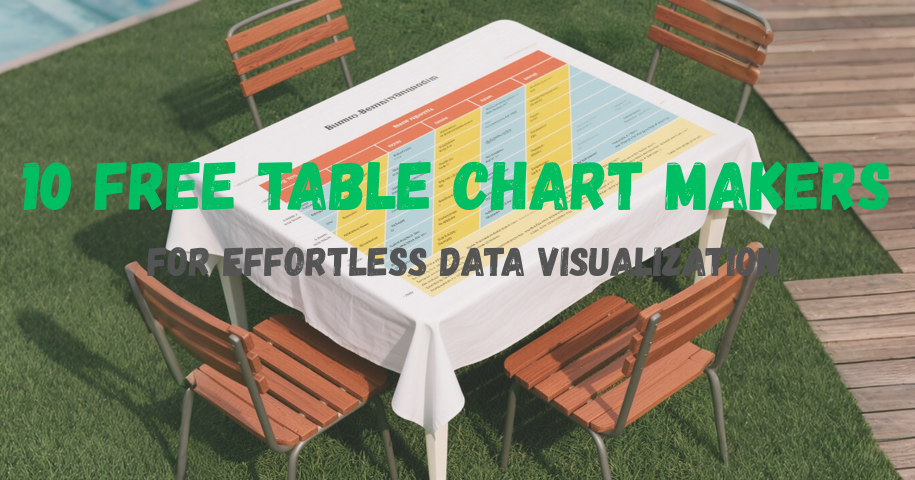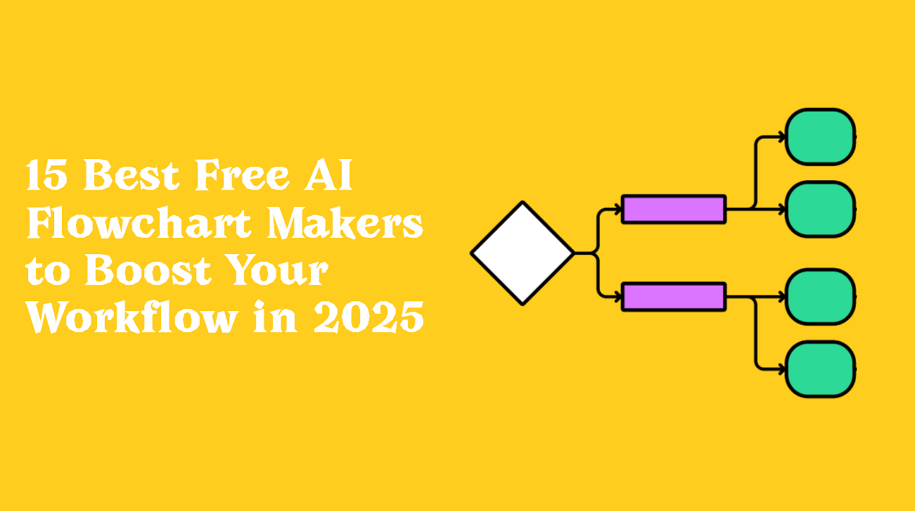
Flowcharts are a powerful way to bring clarity to messy ideas, helping you visualize processes, plans, or concepts in a more intuitive and structured format. But let’s face it—starting one from scratch can be tedious and time-consuming.
Thankfully, in the age of AI, that’s no longer the case.
With the right AI-powered flowchart maker, you can instantly turn your thoughts, documents, or outlines into clean, editable diagrams—without wasting time on layout or formatting. You focus on the ideas, and let AI handle the rest.
Whether you’re mapping a business process, organizing lecture notes, planning content, or creating user flows, this article highlights the top tools that can streamline your workflow and save you hours.
Here’s what we’ll cover:
- Why Use AI for Flowchart Making
- Key Criteria for Choosing the Right AI Tool
- 15 Best Free AI Flowchart Makers
- Let’s dive in and find the perfect tool for your next big idea.
Why Use AI for Flowchart Making?
AI brings a new level of efficiency and intelligence to flowchart creation. Instead of spending time manually drawing boxes and arrows, you can focus on the actual ideas and let AI take care of the structure.
Here’s why AI flowchart makers are becoming the go-to solution:
- Instant results: With the ability to interpret prompts, files, and even websites, AI can transform various types of content into structured diagrams in seconds. This makes brainstorming and documentation much faster and more dynamic.
- Time-saving: AI handles formatting, alignment, and organization automatically, saving users from hours of manual tweaking. It’s especially helpful for recurring tasks like user flows, workflows, or SOPs.
- Flexible formats: Whether you need a mind map, flowchart, Gantt chart, kanban board, or timeline, most AI tools support seamless format switching—letting you repurpose the same content across different visualization styles.
- Smart understanding: Today’s AI tools use advanced language models to understand context, intent, and relationships between items. That means better structure, smarter grouping, and clearer outputs.
- More accessible: You don’t have to be a designer or a technical expert. Just provide input in your preferred form—text, documents, spreadsheets—and the AI handles the rest.
- Data-driven improvements: Many AI tools learn from your interactions over time, making their suggestions more tailored to your specific workflow and diagram style preferences.
- Consistency at scale: AI ensures consistency across your diagrams, which is especially useful for teams working on large projects or maintaining brand standards.
What Factors to Consider When Choosing an AI Flowchart Maker
With dozens of tools on the market, choosing the right AI flowchart maker comes down to your workflow, needs, and preferences. Here are the top factors to evaluate:
- Input flexibility: Does the tool support various input types such as text prompts, documents, presentations, images, spreadsheets, or web links? The broader the input options, the more useful it becomes for different scenarios.
- Output formats: A good tool should support multiple diagram types—flowcharts, mind maps, tables, timelines, kanban boards, and more. The ability to switch between these formats makes your content more versatile.
- Editing control: After AI generates a diagram, can you manually adjust layouts, labels, connections, and colors? Full editability ensures you’re not locked into a rigid output.
- AI capability: Look for tools that go beyond simple generation—those that allow revisions through prompts, support contextual understanding, and refine diagrams based on user feedback.
- Export and sharing: Check whether the tool supports common export formats (PDF, PNG, SVG), collaborative links, or integrations with tools like Notion, Google Drive, or Slack.
- Free tier limits: Consider how many diagrams or AI generations you can access on the free plan, whether watermarks are present, and how much AI credit you get monthly.
- Privacy & security: If you're working with sensitive data, ensure the platform has clear data policies, encryption, and options for offline or on-premise use.
- Scalability: Can the tool grow with your needs? Look for plans that scale across team sizes, offer admin controls, or include analytics and audit logs for enterprise use.
- Learning resources: Well-documented tools with tutorials, templates, and community support tend to reduce onboarding time and improve long-term usage.
Below is a hand-picked list of the top free AI-powered flowchart makers, each with its own strengths. Whether you're looking for smart imports, fast outputs, or collaborative features, there's a tool here to fit your needs.
Each entry includes a quick description, standout features, pros and cons, and the best use cases to help you choose the right fit quickly.
1. Fluig – A Free AI Diagram Tool that generate ready-to-use flowcharts with just AI chats from start to finish, in just seconds
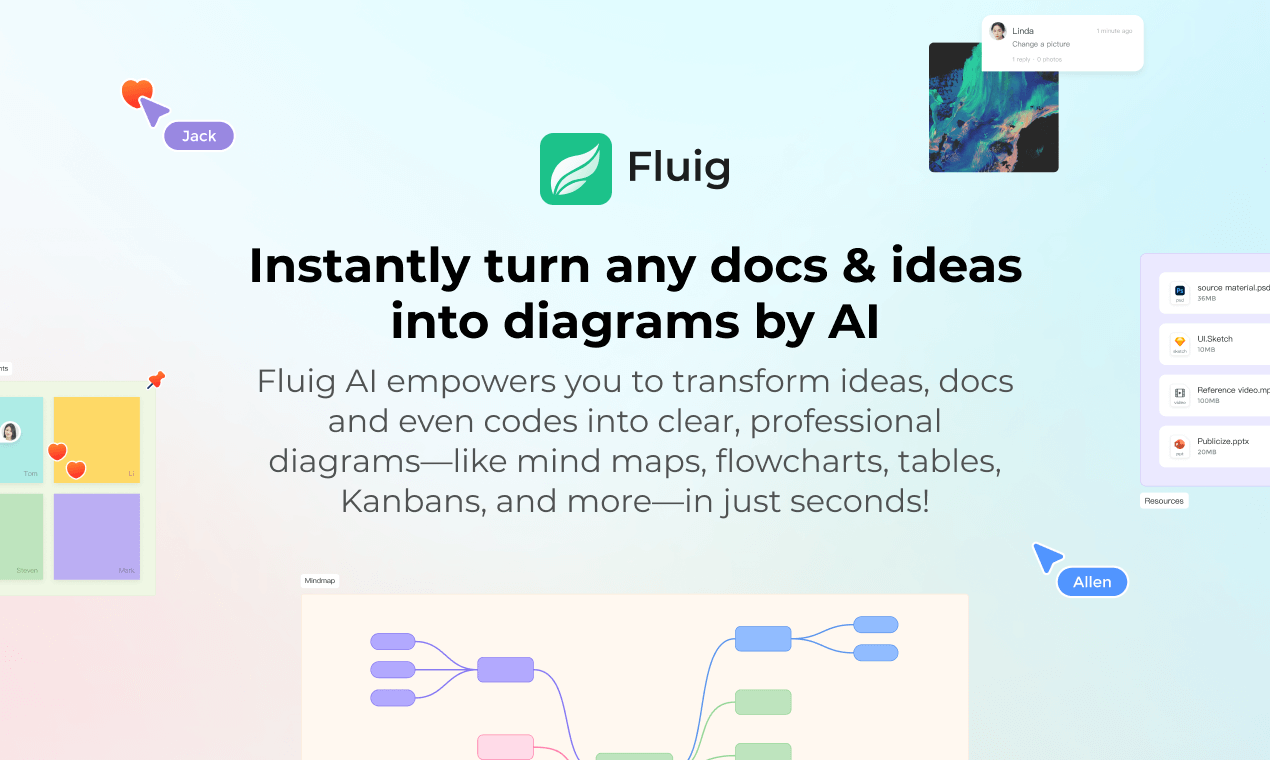
Fluig is a next-generation AI-native diagramming tool designed for rapid idea visualization.
Do you get messy ideas or documents and want to suit them all out quickly with a flowchart or similar diagrams? Fluig, which turns your ideas, documents and codes into flowcharts, mind maps and more with just natural AI charts, is absolutely your perfect choice. No need to build everything from scratch anymore.
What sets Fluig apart is its natural-language interaction and ability to switch between diagram types with simple prompts. No design skills or manual layout needed—just chat with the built-in AI agent and watch your ideas come to life.
Pricing plan:
- Free Plan comes with 3 diagrams + 2,000 AI credits
- Monthly plan is now down to $1/month, with unlimited AI access
Pros:
- Smart file import: PDF, DOC, PPT, images, and over 12 file formats
- Seamless diagram type conversion (e.g. mind map ↔ flowchart)
- Natural language communications
- Real-time collaboration
- Simple prompts to switch between different diagram types
- AI agent
- Slideshow-like demonstration
Cons:
- Limited free AI credits
- Still growing its template library
Best for:
Professionals, product teams, educators, legal and research roles who need flexible and intelligent visual thinking tools
2. Whimsical – Fast Flowcharts from Prompts
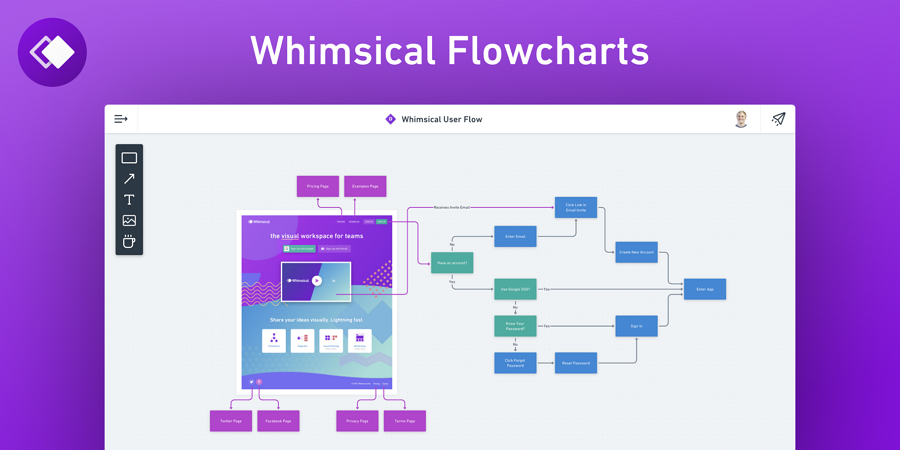
Whimsical is a visually polished tool offering AI-assisted flowchart generation from text. It focuses on rapid ideation, with intuitive controls and beautifully designed components.
Free Plan: 2 free workspaces with limited items
Pros:
- Lightning-fast layout generation
- Supports flowcharts, wireframes, and mind maps
- Real-time collaboration with comments and reactions
Cons:
- Limited free elements
- Focused more on aesthetics than advanced AI logic
Best for: Designers, startups, and teams looking for quick ideation and visual prototyping
3. EdrawMax – Feature-Rich with AI Support
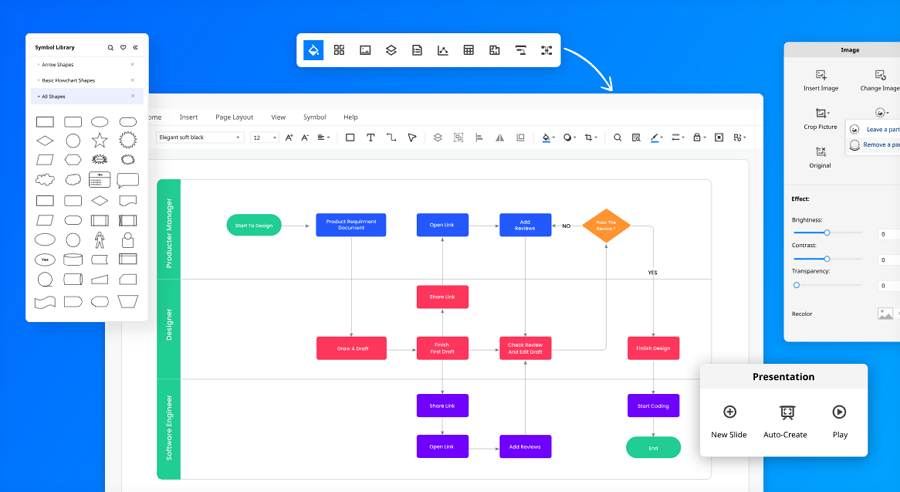
EdrawMax brings robust diagramming tools with optional AI integrations. It supports 280+ diagram types and offers a comprehensive set of shapes and templates. AI helps users jumpstart diagrams based on outlines or imported content.
Free Plan: Limited access with watermark
Pros:
- Huge template and symbol library
- Cross-platform (web, Windows, macOS)
- AI assistance for rapid structure building
Cons:
- Cluttered interface for beginners
- Free plan includes watermarks
Best for: Project managers, engineers, analysts who need diverse diagramming options with some AI automation
4. MyMap.AI – AI-Powered Mapping from Documents
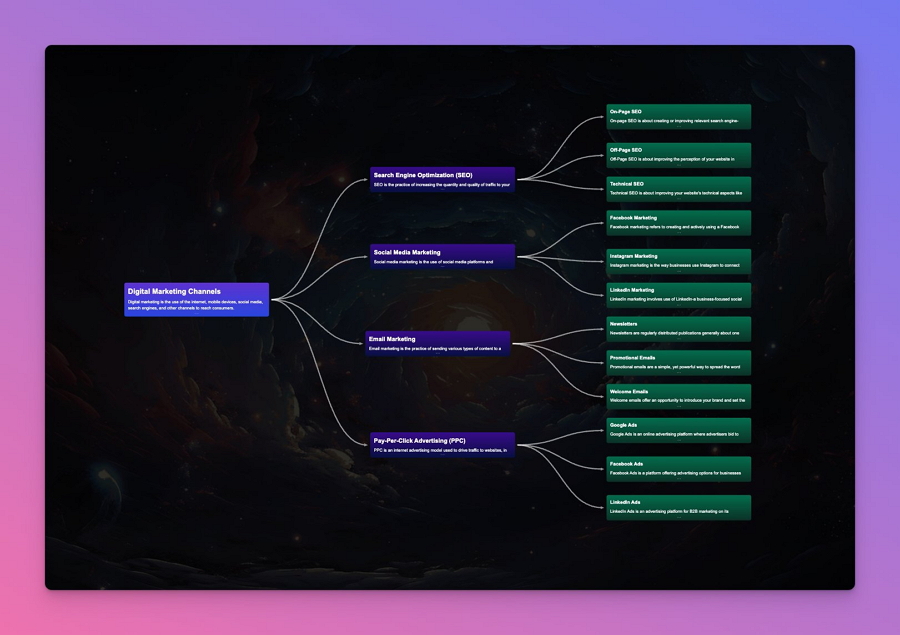
MyMap.AI specializes in turning text-heavy documents into structured mind maps or flowcharts. It focuses on understanding document hierarchy, extracting key points, and presenting them in a visual structure.
Free Plan: Daily free credits
Pros:
- Excellent document summarization
- Simple interface for beginners
- Edit and rearrange generated visuals easily
Cons:
- Fewer diagram types
- Limited AI tuning options
Best for: Students, content writers, and researchers needing clarity from dense text
5. Eraser (DiagramGPT) – Best for Developers and Technical Teams
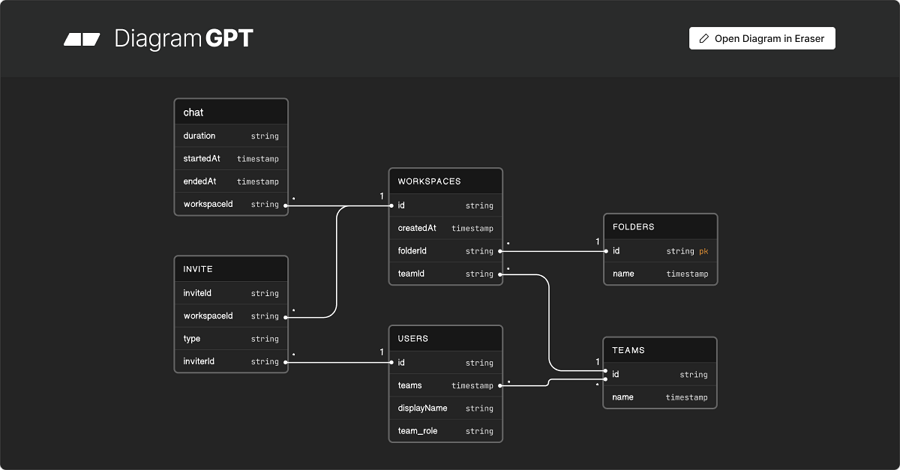
DiagramGPT is a command-driven AI tool built into Eraser for technical diagram generation. From sequence diagrams to architecture maps, it's ideal for developers and engineers who want diagramming without design distractions.
Free Plan: Free with optional upgrades
Pros:
- Markdown and code support
- Supports ER diagrams, UML, sequence flows
- Fast rendering of dev-centric visuals
Cons:
- Not user-friendly for non-coders
- Lacks broader diagram variety
Best for: Dev teams, sysadmins, and database architects
6. NoteGPT – Lightweight Flowcharting from Notes
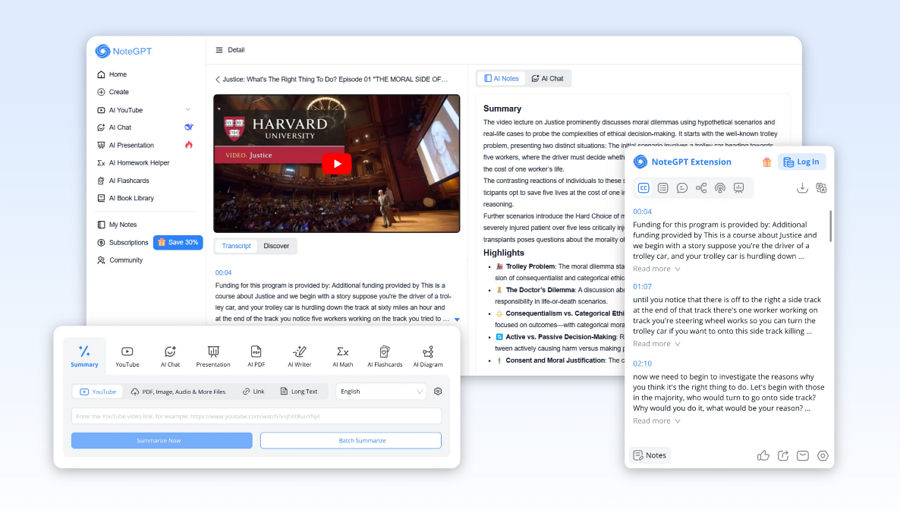
NoteGPT takes meeting notes, lecture summaries, or daily journals and instantly converts them into simple flowcharts or outlines. It's streamlined for everyday productivity.
Free Plan: Free with login
Pros:
- Zero learning curve
- Quick transformation of bullet points into diagrams
- Cloud-based and lightweight
Cons:
- Limited formatting options
- Basic diagram styling
Best for: Students, solo entrepreneurs, and time-crunched professionals
7. Venngage AI – Great for Business and Visual Flowcharts
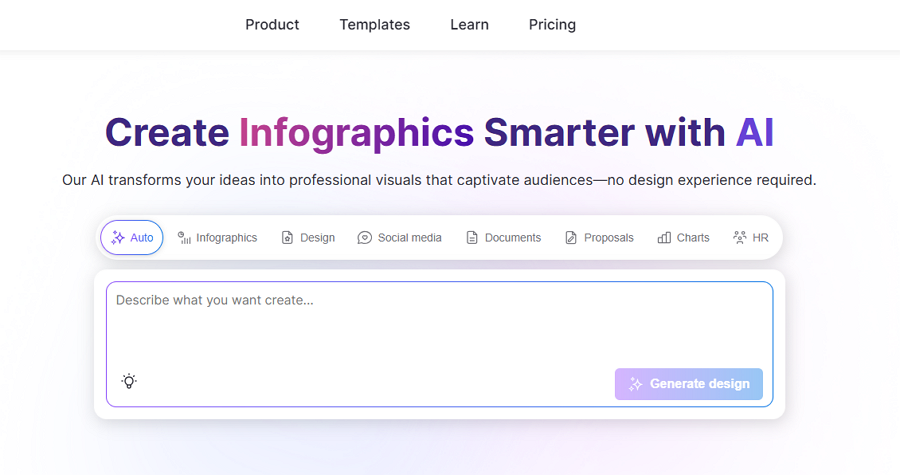
Venngage AI enhances visual storytelling with flowcharts that are visually rich and brand-ready. It provides templates for business workflows, marketing funnels, and infographics.
Free Plan: Watermarked exports, limited designs
Pros:
- High-end visuals for presentations
- Branding tools and design controls
- AI-based smart layout suggestions
Cons:
- Heavily locked behind premium tiers
- Best suited for visual, not functional diagrams
Best for: Marketing professionals, consultants, and brand designers
8. GitMind – Free AI Mind Mapping and Flowcharts
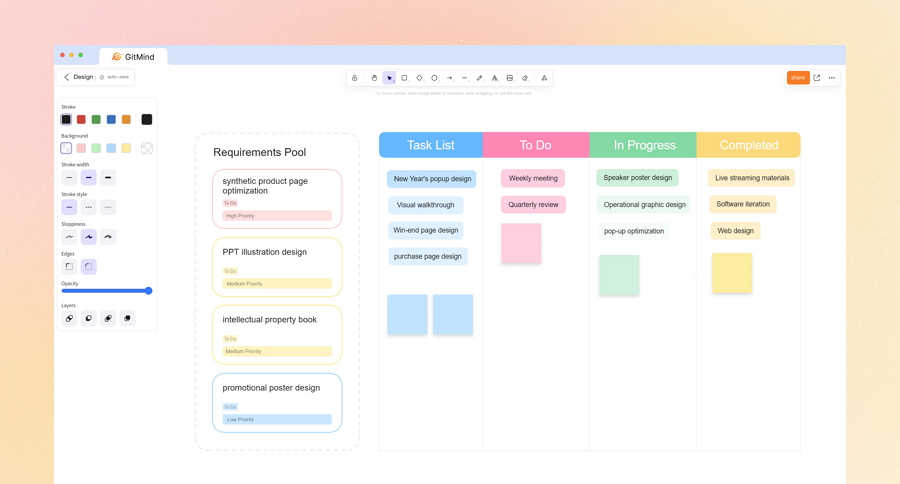
GitMind is a free tool combining mind maps, outlines, and flowcharts. With AI suggestions and multiple export formats, it balances simplicity and functionality.
Free Plan: Unlimited maps with account
Pros:
- Supports AI summarization
- Cloud sync and team collaboration
- Good cross-device experience
Cons:
- Limited in-depth AI customization
- Occasional syncing lags
Best for: Educators, planners, content organizers
9. Diagrams.net (Draw.io) – The Open Source Classic
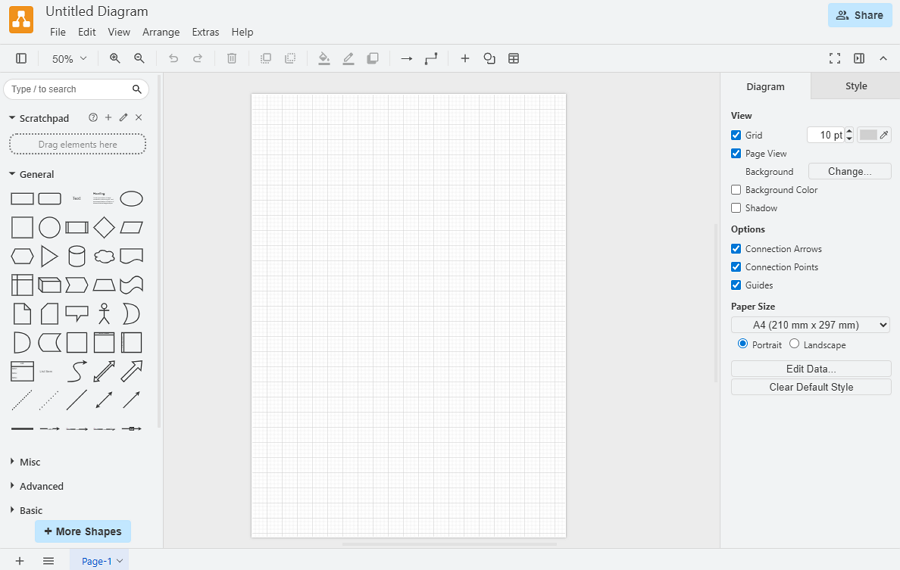
Draw.io is a longtime favorite for privacy-conscious users. While not AI-native, it now includes plug-ins for automated structure and basic AI assistance.
Free Plan: 100% free and offline-capable
Pros:
- Fully open source
- Custom plug-in support
- Data sovereignty and offline use
Cons:
- Limited AI capabilities
- Manual layout still required
Best for: Developers, infosec teams, and power users
10. Taskade AI – All-in-One Team Productivity + Diagrams
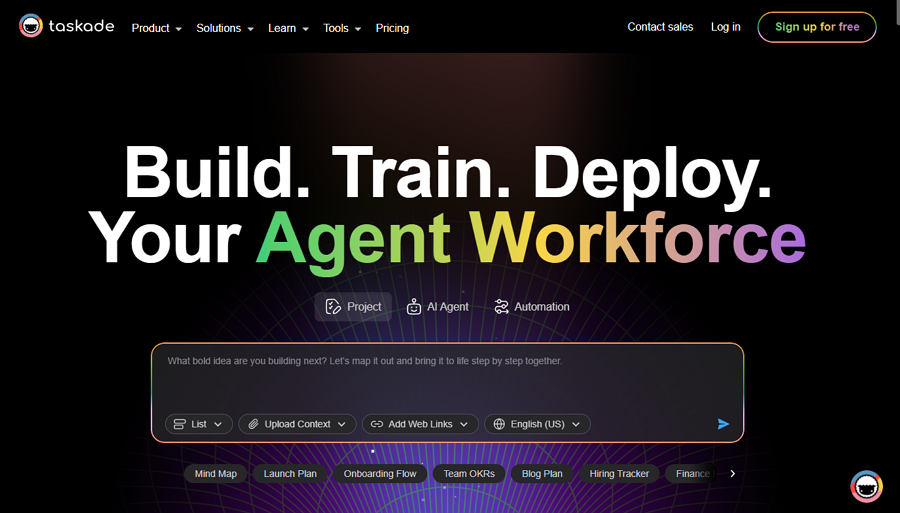
Taskade adds AI and diagramming to its collaboration suite. You can brainstorm, generate flowcharts, and track tasks—all in one place.
Free Plan: Unlimited tasks, basic AI access
Pros:
- Combines productivity + visuals
- Templates for workflows, org charts, SOPs
- Built-in chat and team tools
Cons:
- Limited diagram design depth
- Interface can feel cluttered
Best for: Remote teams, agile squads, startup founders
11. PopAi – AI Chat with Docs + Flowcharting
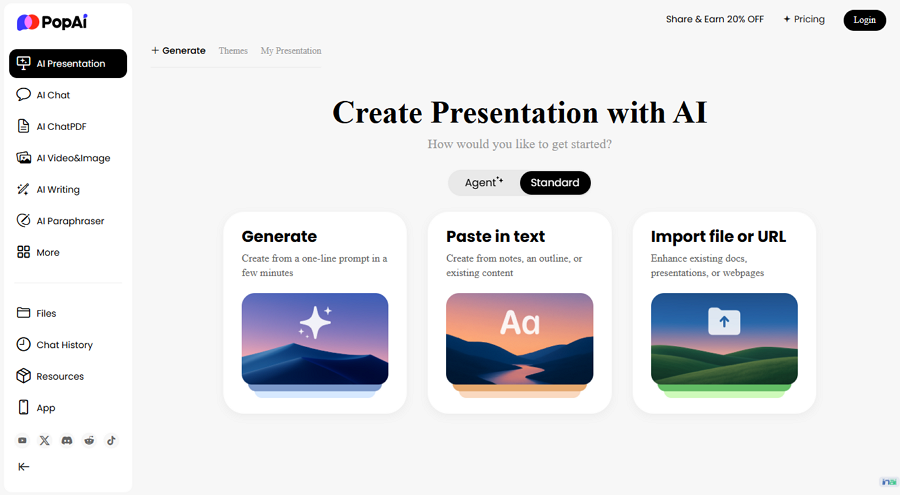
PopAi blends chat-based file Q&A with visual generation. You can upload documents, ask questions, and have the AI generate visual outputs, including flowcharts.
Free Plan: Limited interactions/day
Pros:
- Strong document understanding
- Combines chatbot + visual assistant
- Easy UI with contextual outputs
Cons:
- Free plan limitations
- Not a full diagramming suite
Best for: Legal teams, compliance analysts, knowledge workers
12. Canva AI – Popular Design Tool Meets Diagram AI
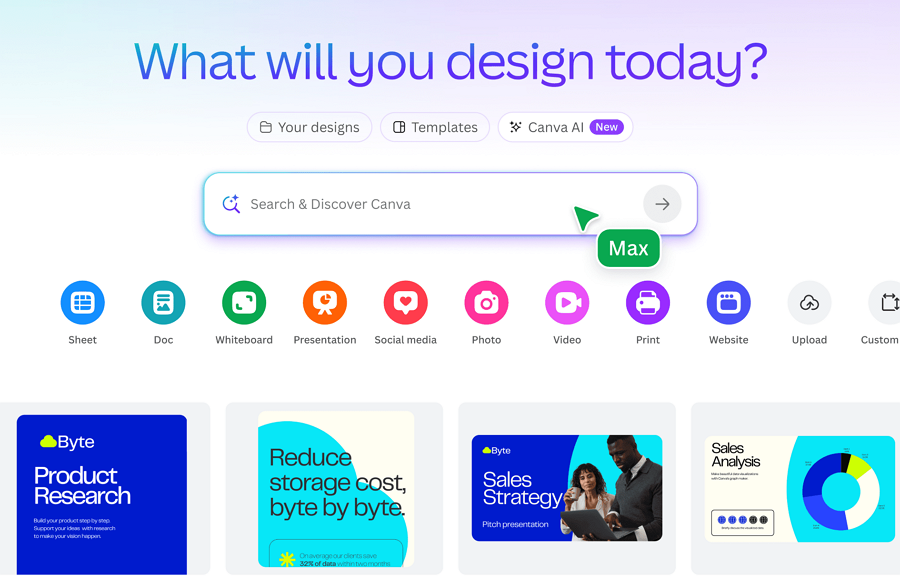
Canva integrates AI into its already-famous visual design platform. Its AI assistant can help structure ideas into diagrams, though it's still better for polished presentations than complex flows.
Free Plan: Basic features with account
Pros:
- Drag-and-drop visuals with pro polish
- Huge asset library
- Brand kit support
Cons:
- Limited intelligent layout
- Not designed for functional diagramming
Best for: Social media teams, educators, freelancers
13. Boardmix – Business Diagramming with AI Templates
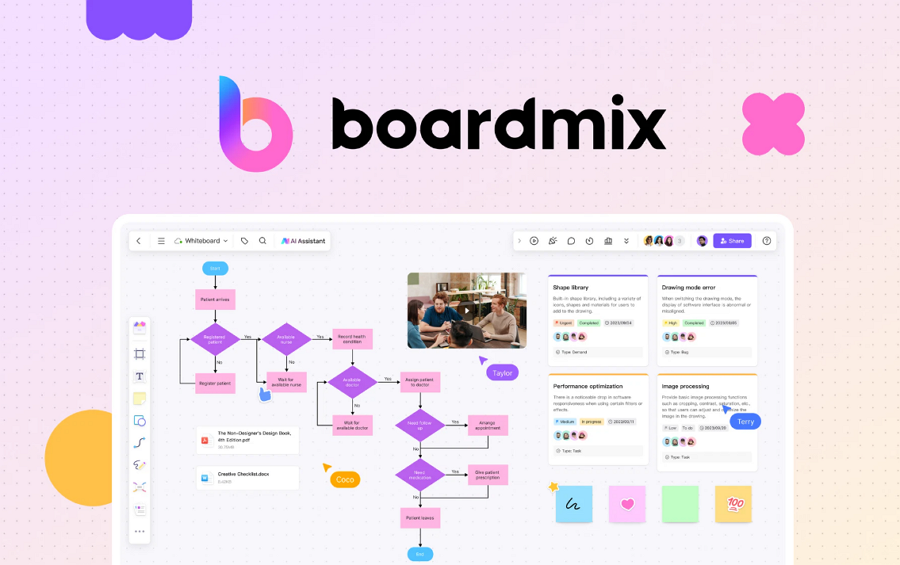
Boardmix combines whiteboarding and diagramming with AI support for business use cases. Templates include OKRs, product roadmaps, and decision trees.
Free Plan: Basic diagrams
Pros:
- Great template coverage
- Business frameworks + AI layout
- Visual-first approach
Cons:
- Premium-leaning features
- Occasional UX glitches
Best for: Business analysts, consultants, strategy teams
14. Zen Flowchart – Minimalist, Fast, and Focused

Zen Flowchart strips diagramming down to its essentials. Its intuitive UI lets users build and share diagrams in seconds.
Free Plan: Basic features free
Pros:
- Fastest tool for simple flows
- Clean UI with zero distraction
- Good for embedding or documentation
Cons:
- No AI generation
- Limited diagram types
Best for: Writers, editors, quick-process mapping
15. Lucidchart AI Labs – Enterprise-Grade Powerhouse
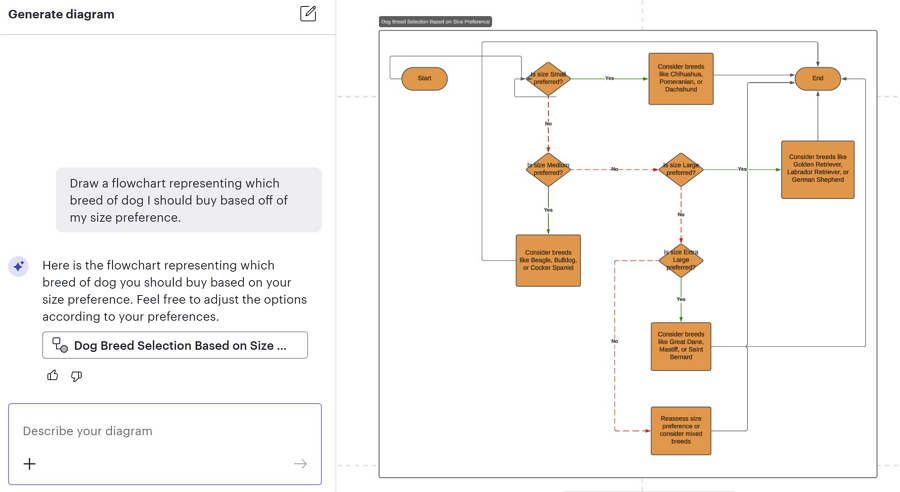
Lucidchart’s AI Labs add smart features to one of the most powerful diagramming platforms. Enterprise teams can build intelligent flows, sync with data, and use AI to refine complex structures.
Free Plan: Limited objects and features
Pros:
- Data-driven diagramming
- Enterprise-grade integration (Atlassian, Google, MS)
- Advanced permissions and templates
Cons:
- Steep learning curve
- AI features gated behind business plans
Best for: Enterprises, system architects, operational teams
Conclusion
AI is redefining how we create, collaborate, and communicate ideas. Flowchart makers powered by AI remove the barriers of design, letting you turn complex input into elegant visuals effortlessly.
Whether you want a no-frills generator or a multi-format diagram workspace, there's a tool here to match your needs. Among all, Fluig stands out as a fully AI-native platform, making it a top choice for professionals who need to move fast and think visually.

